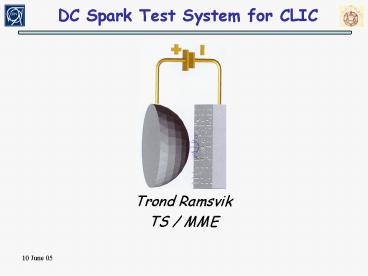DC Spark Test System for CLIC PowerPoint PPT Presentation
Title: DC Spark Test System for CLIC
1
DC Spark Test System for CLIC
- Trond Ramsvik
- TS / MME
2
Outline
- Introduction
- Motivation, Origin of Breakdown, Materials
- Experimental Setup
- Field Emission
- Breakdown Field
- Local Field
- Automatic Spark Conditioning
- Effect of Residual Gas
- Further work
- Conclusions
- Introduction
- Motivation, Origin of Breakdown, Materials
- Experimental Setup
- Field Emission
- Breakdown Field
- Local Field
- Automatic Spark Conditioning
- Effect of Residual Gas
- Further work
- Conclusions
3
Introduction Why DC spark experiments?
- With a DC spark-test system, materials can be
subjected to high electric fields, and their
properties and responds to different treatments
can be examined relatively easy and quickly.
4
Introduction Origin of Breakdown
- The physics of breakdown is still not perfectly
understood - Commonly accepted that breakdown at small gaps
(d 0.5 mm) is initiated by an electron field
emission based mechanism from one or a few
microprotrusions - Process towards breakdown. Suggested Models
- Anode-initiated
- electron bombardment of anode
- release of gas and/or anode material through
intense localized heating or electron stimulated
desorption (ESD) - Avalanche ionization of the released species
- Cathode-initiated
- The microprotrusion on the cathode becomes
unstable - ohmic heating from high field emission current
density - fracture of the surface due to the tensile stress
produced by the electric field - Exchange
- Avalanche of mutual secondary emission of ions,
electrons between the electrodes
High Voltage Vacuum Insulation, edited by R. V.
Latham (Academic, New York, 1995).
5
Introduction Choice of materials
Criteria
- low vapor pressure
- high tensile strength
- high melting point
- high thermal conductivity
- high electrical conductivity
6
Experimental Setup
Sphere / Plane geometry
7
Field Emission
Fowler Nordheim plot
- R. A. Millikan and C. C. Lauritsen, Proc. Nat.
Acad. Sci. (US), 14, 45-49 (1928) - R. H. Fowler and L. Nordheim, Proc. Roy. Soc.
A 119 (1928) 173.
8
Fowler Nordheim plot
Molybdenum Tip and Sample
9
Enhancement Factor (ß)
Results from Fowler Nordheim plots
Molybdenum Tip and Sample
Emission Radius (re) nm
Before bake-out ß (40 10) re (2 ? 11)
nm After bake-out ß (60 10) re (5 ? 40)
nm
10
Spark Cycle
The voltage over the gap is increased until
breakdown occurs
Molybdenum Anode and Cathode
Gap 20 ?m
11
Local Field
Field evaporation ? Tensile Strength
Measured tensile strength of Mo 750 MPa
Elocal 11 GV/m (max 21 GV/m)
?tensile 520 MPa (max 1950 MPa)
12
Automatic Spark Conditioning
13
Automatic Spark Conditioning
Molybdenum (Mo) Tip and Sample
Histogram
Spark Scan
14
Scanning Electron Microscopy
Molybdenum surface after 1600 sparks
Average energy per spark 0.8 J
Outside spot
15
Electro Discharge Machined (EDM)
EDM
Mo
16
Gas Experiments
- From literature
- Pressure effect on the breakdown field
significant for large gaps - Breakdown field deteriorates at pressures
typically above 10-2 mbar
R. Hackham and L. Altcheh, J. Appl. Phys., 46,
627-36 (1975)
17
Gas Experiments
Baked system Laboratory Air
Unbaked system Dry Air
Clear effect on pressure also at high vacuum /
small gap (!)
18
Gas Experiments
19
Spark Conditioning vs. Pressure Rise
Pav 410-8 mbar
Mo Tip Sample
At start Follows the amount of energy deposited
over the gap Slight decrease in pressure rise
during spark Pressure rise typically in the order
of a few percentage per spark
20
Comparison Molybdenum - Tungsten
21
Comparisons - 30 GHz measurements
M. Kildemo, S. Calatroni and M. Taborelli,
PRST-AB, 7, 092003 (2004)
Saturation breakdown field measured at
(2-4)10-8 mbar
22
Future Work
- Installing new sampleholder and manipulator
- XYZ movements
- E-beam heating ? 1000oC
- In-situ annealing
- several samples
- more experiments to study the effect of residual
gas on the Mo breakdown field - pressure rise studies at UHV (110-9 mbar)
- other materials CuZr, Ti, Mo-Re alloys,W-films,
23
Conclusions
- Surface preparation techniques influence the
conditioning speed - There is a residual gas effect on the breakdown
field also for high vacuum and small gaps - From 110-9 mbar to 110-6 mbar a reduction in
the saturated breakdown field of 150 MV/m is
seen - Molybdenum shows higher DC saturation breakdown
field than Tungsten after extensive spark
conditioning - Similar to the results found for RF
24
Contributors
- Morten Kildemo
- Sergio Calatroni
- Mauro Taborelli
- Holger Neupert
- Gonzalo Arnau Izquierdo
- Ahmed Cherif
- Ana Sousa E Silva
- Alessandra Reginelli
25
Movement of electrons in RF
Phase of RF field
? 2p33109 s-1
q 1.610-19 C
E0 330106 MV/m
Me 9.110-31 kg
f 0
z0 0
26
Depth profile / ca. 100 sparks
27
XPS
After 1600 sparks and exposed to air
- Carbon reduced
- Oxygen unchanged
- Molybdenum peaks stronger
Alessandra Reginelli TS/MME
28
Vickers ? Tensile Strength
C. Bourgés Monnier, Propriétés du molybd è ne et
des alliages à base de molybdene, Ecole des
mines, Paris
29
(No Transcript)
30
Details of experimental setup
HV supply 0 to 12 kV
HV switching electronics
Q-meter
UHV
Tip
Sample
PC
A-meter
Scope

